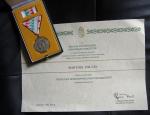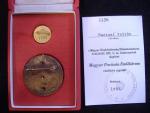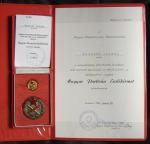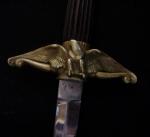-
Posts
2,660 -
Joined
-
Last visited
Content Type
Profiles
Forums
Blogs
Gallery
Events
Store
Everything posted by hunyadi
-

Soviet manufactured, non-Soviet awards
hunyadi replied to Bob's topic in Central & Eastern European States
I would vote out Hungarian manufacture as I have hardly ever seen any Afghan awards here. With the "Kadarism" by the 1980's the link with the SU was pretty weak by then and the Hungarians saw the invasion of Afghanistan as a similar event to Hungary in 1956. The Czechs also had a mint and produced some of the N Korean awards so there may be a link there also? -

Bulgaria Bulgarian Col General
hunyadi replied to hunyadi's topic in Central & Eastern European States
Sorry - the tunic is now in storage so I will have to get back to taking more photos of it at a later date -
It actually translates to 'Excellent Alumni'.
-

Hungary Order of Labor in Gold
hunyadi replied to hunyadi's topic in Central & Eastern European States
Mostly you begin to use the 'spidey sense' when handling pieces and get a good interpretation of when it was made after handling so many things. Of course this is looking at the quality of the items and the construction methods, these consitstently degraded in what ammounts to a proces that can be generally broken down into decades. Now - after your observation, I went and looked at all the threads and my inventory photos. I think it would be safe to say that - yes - certainly the earlier pieces do have the 'bulging star' while the cold enamel types commonly encountered are flush. -

Hungary Hungarian Kivalo Dolgozol Badges
hunyadi replied to hunyadi's topic in Central & Eastern European States
That would be a varaint - sort of.... The badge you have is for 'Excellent Work in the Industrial Cooperative'. The one Zsolt showed was the 'Excellent Work in the Craftsman Cooperative'. Apparently this was instituted on Novemebr 1st, 1957. Hot enamel would probably indicate an award from the late 1950's early 1960's on this one. -

Hungary Order of Labor in Gold
hunyadi replied to hunyadi's topic in Central & Eastern European States
Of course you would ask such a great question when I have everything packed up..... -
Hi Alex - without my references with me its hard to recall the different styles - I believe that this is a 1917 model (?). Probably a parade style tuinc. Certainly looks very period and typical. The shoulder patch was added post war when the practice became more popular for reunions, veterans day parades and such... The patch is for the 91st Infantry Division. Here is a nice site on the history http://members.aol.com/ItalyWW2/Division91.htm Once again the tunic shown here is missing the collar devices - these were cut out style pins (crossed rifles, artillery, etc...) with a unit number added. They were rather large and looked like they would snag on just about anything. Bullion captains bars and the overseas stripes (3 = 1 1/2 years overseas service) are very period and desireable. Are these your items? Nice collection you have started there!
-
Alex - a corporal and sergeant would wear the typical chevrons where the patch is on this one. Then the designation for an aviation unit would be identified by the collar disks - which of course are removable....so what you have there is 99% certainly an original aviation unit uniform. I am sure that somewhere there is a comprehensive listing of the patches and such. Men at Arms did a pretty good book about WW1 uniforms - but I dont have it here anymore so I cant give much more than that.
-
Alex - these are representative at best - the one on the far right is a Signals disk - as the aviation units were intended for observation for artillery, many aviation units used these. There is aslo a rare winged propeller disk that could be used. The "unit disk" was generaly worn on the left side of the wearer while a state, national or designation (reserve, millitia, etc...) was used on the right. http://cgi.ebay.com/NICE-LOT-OF-THREE-WWI-...1QQcmdZViewItem
-

Pair Of Hungarian Medals With Documents
hunyadi replied to Verdun16's topic in Central & Eastern European States
Yes - these are to a an who severd in the 17th Infantry Regiment. Dont have my unit histories with me anymore so I cant tell you more than that. Documents are for the return of the Northern Territories (white doc) and Return of Transylvania (blue) Interesting to see: 1) Northern Document states it is for the 'return of the northern lands' 2) Transylvania is for the 'liberation' of Transylvania.... -
From what I can see - the unifomr is original. Missing the collar discs. The aviation patch looks original to the tunic as it looks 'imbedded' into the wool of the sleeve. The Aviation patch (or any other patch in that location) was denoted to indicate the rank of "Private". The chevron in the middle of the left sleeve is the "discharge" stripe: meaning he could wear the uniform for some time after being discharged from the armed forces (this way the Military Police would be less likely to pick you up for appearing to be AWOL) the silver stripe below that indicates 6 months of overseas duty. What is nice to see is that it is sans a 'unit pacth' or SSI on the left sleeve as well. This was a common practice AFTER the war (though some divisions created theirs during the war hence setting the precidence). The unifomr was worn on the troop ship home, had a drink at the local pub and then hung it with care in the closet for nearly 80 years....
-
That ribbon is about as generica as they come. They were used on firemans medals of WW2 era, sport medals, patriotic things of 1948, teachers medals of 1953 (not in that book), trade union medals, etc.... My observations on this would place production around 1940 to mid 1950's. Ribbon wire is 'wire', steel gromet, and the better quality silk all indicate a product from this era.
-

Hungary Hungarian Partisan Grouping
hunyadi replied to hunyadi's topic in Central & Eastern European States
It certainly is a grouping that has me scratching my head while at the same time going WOW! -

Hungary Hungarian Partisan Grouping
hunyadi replied to hunyadi's topic in Central & Eastern European States
And the real twist - In 1993 he was awarded Commemorative Medal of the Independant Democratic Hungary. Awarded to individuals who were memebrs of the armed forces after March 9th, 1945 who participated in ridding Hungary of the Nazi occupation - IE - those who volunteered to join the Hungarian Red Army - though they never saw any real action (two units did become supply units for the Red Army - but that was about it) So - not long after surrendering to the Soviets - he joined the forming Hungarian army (as sitting in a POW camp was more dangerious) Only 4500 of these were awarded 1000 of the posthumiously. As Zoltan passed away this year he was one of 3500. -

Hungary Hungarian Partisan Grouping
hunyadi replied to hunyadi's topic in Central & Eastern European States
But wait - there is more! In 1966 he was awarded a 15 year service medal. Retro - so he enterd the military as an officer in 1951.... -

Hungary Hungarian Partisan Grouping
hunyadi replied to hunyadi's topic in Central & Eastern European States
The reverse of the badge and the carrying document - these documents were not intended to have a serial number - though this one was added. -
Martosi Zoltan was born in 1920 and moved to a house near the outskirts of Budapest with his family in 1932. In 1944 Zoltan was conscripted into the Royal Hungarian Army and was stationed at ?sv?nyr?r?n where he rose to the rank of squad leader awaiting his time to engage the enemy. During Christmas of 1944, the young corporal was given a two day pass to visit his parents in Budapest from December 23rd to the 25th. He arrived on a German transport truck to his house. The battle was fierece and the Red Army was encircling the capitol city. Zoltan spent the holidays with his family in a nearby bomb shelter. When his pass expired on the 25th, the city was surrounded and it was impossible for him to return to his unit. He remained with his family till he was arrested on the 30th for desertion. He sat in a prison for ten days as he awaited his fate - most likely execution. Then he managed to find that a friend of his was a personal friend of the Military Police Colonel and they managed to convince him to release Martosi under the circumstances. The condition of his release was that his new papers assigned the corporal to the SS Division Maria Theriesia. With the new papers - he tried to slip away even but the shelling and fighitng was so intense that he could not get home - so he went to Ulloi Ut to the barracks of the SS Division...still in his Hungarian uniform - but on the roll call of the SS Division, Martosi continued to hold the line as the Division slowly pulled back to the Castle District. When the final order came to retreat to the castle - their Hungarian platton offcier, an Artillery Lieutenant refused (the castle became a death trap). On February 11th Martosi's platoon surrendered to the Red Army. Though he never made it home during the battle - a German platoon occupied his parents house as it was an excelent defensive position. Martosi's family hid in the nearby shelter, but then later assisted the Germans in the defense. His father was killed delivering ammunition to the Germans in his house. Recently at auction I was able to aquire nearly all of the grouping to Martosi Zoltan. Interestingly he was awarded the Partisan badge in 1983. This was normaly done for individuals who through some effort had worked to condem the rise of European Faschism through service or literature. Zoltan may have done such work, but it is not known at this time - it may also have been a situation where his serivce to the HUPR combined with the fact that he 'tried to defeat Hitler's army' by attempting to desert may have warranted the badge. Its unknown at this time. However - what is interesting is that accorind to others I have spoken to, only about 200 Partisan badges were handed out in 1983 - though many of the un-numbered badges appear regularly from this time. What is strikingly interesting about this particular badge (besides the ultra rare document) is that the badge awarded and recorded on the carrying document is an early issue numbered 1136! This could be that it was a 'New Old Stock' or that the 1950's made ones were not handed out in a particular order, or it may also have been a badge that was revoked from the previous owner...uncertain? Regardless -the irony is that he was named a 'partisan' - yet he was a member of an SS Division....
-

Hungary my latest purchaes
hunyadi replied to Ulsterman's topic in Central & Eastern European States
"Merited" sounds good - the ELENJARO seems to be a 'lesser' degree from what I can gather. -

Hungary my latest purchaes
hunyadi replied to Ulsterman's topic in Central & Eastern European States
From foggy memory I believe I was told 1976.... along with the long blue 'proficiency badges'. -

Hungary my latest purchaes
hunyadi replied to Ulsterman's topic in Central & Eastern European States
Upper Left: "Exceptional Battalion Commander" Upper Rigtht "Excellent Platoon Commander" and of course an April 4th Parade Badge -

Hungary Axis Allies Air Force Daggers
hunyadi replied to hunyadi's topic in Central & Eastern European States
Button for securing it in place. Mostly hidden by the latch is the makers stamp - a Holy Hungarian Crown...thats it... -

Hungary Axis Allies Air Force Daggers
hunyadi replied to hunyadi's topic in Central & Eastern European States
Detail of the cross guard - lots of wear on the eagle - but see how the wings 'flow' over the cross guard and are not cut out... -

Hungary Axis Allies Air Force Daggers
hunyadi replied to hunyadi's topic in Central & Eastern European States
-

Hungary Axis Allies Air Force Daggers
hunyadi replied to hunyadi's topic in Central & Eastern European States
reverse...sorry for the poor pictures - the point-n-shoot does not do well with items this size. Too far away for macro and too close for normal...










